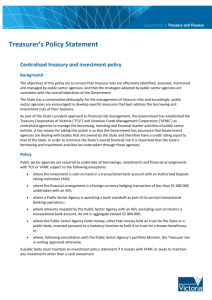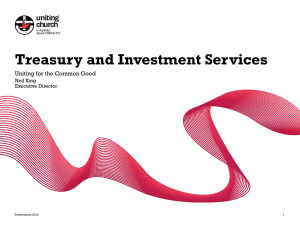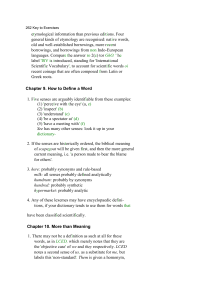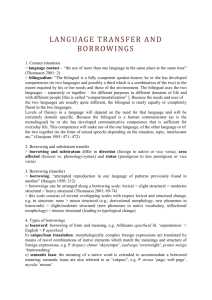Investment and Liability Management Policy - Our 10
advertisement
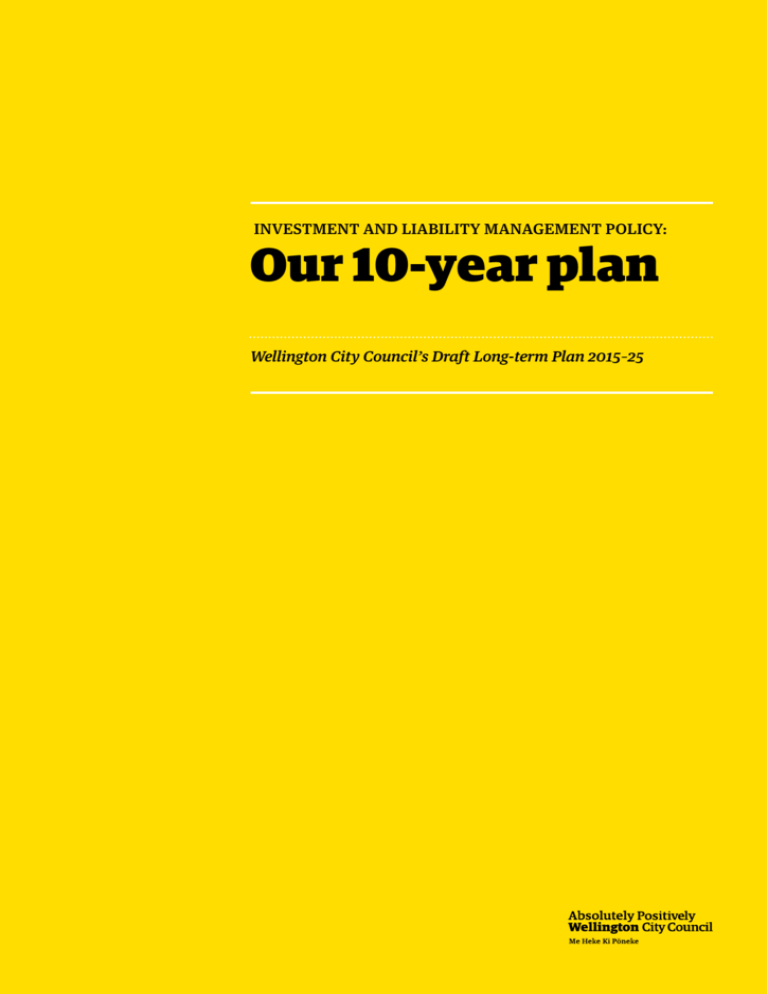
INVESTMENT AND LIABILITY MANAGEMENT POLICY: Our 10-year plan Wellington City Council’s Draft Long-term Plan 2015–25 Investment and Liability Management Policies GENERAL POLICY OBJECTIVES The Council’s general policy objectives relating to its investment and liability management are to: Minimise the Council’s overall costs and risks associated with its borrowing activities and the general management of its other liabilities. Manage its borrowings and cash assets on a “net debt” basis in order to reduce the overall net cost to the Council. Optimise the return on its investment portfolio and other financial assets. Manage the Council’s exposure to adverse interest rate movements. Borrow and invest funds and transact risk management instruments within an environment of control and compliance. Regularly review and consider the performance of the Council’s financial assets and investments. Where appropriate, the Council will dispose of under performing assets or those assets and investments that are not essential to the delivery of services and activities set out in the Council’s Long Term Plan (LTP). More detail on the Council’s investment and borrowing policies, operating procedures and associated internal controls is contained in the Treasury Management Policy. INVESTMENT POLICY Policy Statement The Council operates on a “net debt” basis, and does not separately maintain significant long term cash investments. The general policy with respect to surplus short term cash is to invest any short term surplus cash or to utilise it to reduce borrowings. The Council currently maintains an equity interest in Wellington International Airport Limited (WIAL) and an ownership and financial interest in ground leases and investment properties. The Council will continue to review the level of investment as well as the return it receives on these investments. Where appropriate, the Council may choose to dispose of investments/financial assets that no longer meet our investment objectives. Draft for Consultation - not Council Policy 1 Investment Mix and Associated Objectives The Council categorises its investments into 5 broad categories: Cash and Cash Equivalents The Council may invest funds with approved registered banking institutions. These investments generally mature in less than one year, and are held primarily for working capital/liquidity purposes or the pre-funding of debt maturing within twelve months. Income generating commercial debt instruments These are principally loans to other organisations (on commercial terms) which deliver a cash-flow return to the Council. Income generating commercial equity investments Equity investments arise from the Council owning or controlling an equity holding (e.g. shares) in another entity. The Council currently maintains a 34% shareholding in Wellington International Airport Limited (WIAL). In the event that a call for capital is made by WIAL the Council’s objective is to maintain its shareholding at 34% unless a specific resolution is passed not to do so. As a result, should the Council be required to inject additional capital in WIAL to maintain its existing shareholding, it will do so without further consultation. Income generating commercial property investments Investment properties are the Council’s ground leases and land and buildings held primarily for investment purposes. The Council periodically reviews its continued ownership of investment properties by assessing the benefits of continued ownership in comparison to other arrangements that could deliver similar benefits. Any assessment is based on both the strategic benefit of the investment/ownership to the City and in terms of the most financially viable method of achieving the delivery of Council services. Non income generating investments This includes loans to other organisations, and equity investments in Council Controlled Organisations. The Council may consider the provision of loans to Community groups but only in exceptional circumstances. The Council’s non income generating investments are held for strategic or ownership reasons. In addition to the above investment categories, the Council may assume financial risk associated with providing contributions, guarantees and underwrites, where these meet the Council’s strategic objectives and outcomes. Such undertakings require a Council resolution. New Zealand Local Government Funding Agency Limited Draft for Consultation - not Council Policy 2 The Council currently maintains a 8% shareholding and other financial instruments of the New Zealand Local Government Funding Agency Limited (LGFA). The Council's objective in making any such investment is to: a. obtain a return on the investment; and b. ensure that the LGFA has sufficient capital to remain viable, meaning that it continues as a source of debt funding for the Council. Because of this dual objective, the Council has invested in LGFA shares in circumstances in which the return on that investment is potentially lower than the return it could achieve with alternative investments. The Council has also subscribed for $2m of uncalled capital in the LGFA. Investment Acquisition/Addition/Disposal With the exception of the day to day investment of short term cash and cash equivalents, all new investments, additions to existing investments, and/or disposals of existing investments must be approved by the Council. The day to day management and investment of short term cash and cash equivalents may be made by Council officers in accordance with the Treasury Management Policy. The Council will continue to maintain its current level of investment in WIAL (being a 34% equity interest) until it considers that it is strategically, financially and economically prudent to dispose of the investment. Proceeds from the sale of investments will be used to repay existing borrowings, unless the Council specifically directs that the funds be put to another use. Reporting Investments in CCOs Monitoring of the Council’s equity investment and ownership interest in Council Controlled Organisations (CCOs) is undertaken by the Council Controlled Organisation Performance Sub-Committee. The Sub-Committee reports to the Governance, Finance and Planning Committee and is responsible for: monitoring Council Controlled Organisations (CCOs), Council Controlled Trading Organisations (CCTOs), and Council Organisations (COs), reviewing the above organisations' quarterly reports, annual reports, business plans, strategic plans and statements of intent, and monitoring the performance of appointed members on CCOs. All other investments Draft for Consultation - not Council Policy 3 The Governance, Finance and Planning Committee is responsible for monitoring all other investments and providing recommendations to the Council in regard to strategies, policy and guidelines in relation to those investments. The Governance, Finance and Planning Committee will receive and review the quarterly Treasury report contained within the consolidated quarterly report. Risk Management The Council’s principal exposure on its financial investments is credit risk. Credit risk is minimised by the Council investing in approved institutions with satisfactory credit ratings which are assessed and reviewed by independent credit rating organisations. Limits are spread amongst a number of counterparties to avoid concentrations of credit exposure. Assessment and management of specific risks associated with the Council’s investment in WIAL, LGFA and investment properties will be performed on a regular basis. Any significant changes in the risk profile for these investments will be reported to the Governance, Finance and Planning Committee. Investment Ratios For the purposes of setting its Borrowing and Investment Ratios, the Council defines investments as assets which are cash or readily convertible to cash (either through fixed repayment and maturity profiles, or through sale or exchange) and assets which are held primarily for investment purposes (either for capital growth, commercial rental or interest). This is likely to include: Cash and cash equivalents (e.g. term deposits), Income generating commercial debt instruments Income generating commercial equity instruments Income generating commercial property instruments Draft for Consultation - not Council Policy 4 LIABILITY MANAGEMENT POLICY In broad terms, the Council manages both current and term liabilities. CURRENT LIABILITIES Current liabilities reflect those obligations, expressed in monetary terms, which the Council has to meet within relatively short timeframes, at a maximum within the next 12 months. In respect of its day to day obligations for both operational and capital expenditure, the Council’s policy is to pay these liabilities in full by the due date. This eliminates any credit exposure or risk. Current liabilities also include the maturing portions of any term liabilities that are due for repayment within the following 12 months. TERM LIABILITIES Term liabilities represent the Council’s obligations which, in general terms, are not immediately payable, i.e. not due within the following 12 months. Borrowings comprise the majority of the Council’s term liabilities. The Council approves the borrowing programme for each financial year as part of the LTP or Annual Plan. Additional borrowings may be approved by Council on a case by case basis. The Council primarily borrows to fund its new and upgraded capital expenditure programme. In approving new borrowings the Council considers the impact of the proposed level of borrowings on its overall borrowing limits and impact on rates and rates limits. POLICY OBJECTIVES The Council primarily borrows to pay for the upgrading of existing assets and the construction/purchase of new assets. These assets generally provide new or enhanced benefits to Wellington for many years. Borrowing is therefore considered the most cost-effective and equitable way to fund these assets as it spreads the cost of the asset over the future generations of ratepayers who will benefit from the use of the asset. In addition, Council borrows to meet the costs associated with settling liabilities arising with respect to weathertight homes issues, and the borrowings are repaid from future rates revenues. Accordingly, borrowings have a strategic benefit of making the cost of the asset investment or weathertight homes liabilities affordable to today’s ratepayers. Borrowings are maintained at a prudent level, in accordance with the Council’s overall financial strategy and specific borrowing limits. POWER TO BORROW The Council borrows as it considers appropriate and in accordance with the provisions of the Local Government Act 2002 and its Treasury Management Policy. The Council approves the level of new borrowing in general terms as part of the LTP or Annual Plan. The Council delegates the authority to officers to raise the approved borrowing during the financial year as and when the funding is required. Any additional borrowing beyond that approved in the LTP or Annual Plan must be approved by the Council. Draft for Consultation - not Council Policy 5 INTEREST RATE EXPOSURE Borrowings issued at variable (floating) interest rates expose the Council to a cash flow interest-rate risk. The Council manages its cash flow interest-rate risk by using floating to fixed interest rate swaps. Such interest rate swaps have the economic effect of converting borrowings from floating rates to fixed rates. The Council has set the following specific limits for its interest rate exposure: MASTER FIXED/FLOATING INTEREST RATE RISK CONTROL LIMIT Minimum Fixed Rate Maximum Fixed Rate 50% 95% The level of fixed interest rate cover at any point in time must be within the following maturity bands: FIXED RATE MATURITY PROFILE LIMIT Period Minimum Cover Maximum Cover 1 to 3 years 15% 60% 3 to 5 years 15% 60% 5 to 10 years 15% 60% LIQUIDITY The Council minimises its liquidity risk by avoiding concentration of debt maturity dates and by maintaining committed borrowing facilities at a level that exceeds 115% of the existing external net debt level. The Council will only drawdown or borrow against these facilities as required. Where special funds are maintained to repay borrowings, these investments are held for maturities not exceeding borrowing repayment dates. The Council avoids exposure to liquidity risk by managing the maturity of its borrowing programme within the following maturity limits: BORROWING MATURITY PROFILE LIMITS Period Minimum Maximum 0 to 3 years 20% 60% 3 to 5 years 20% 60% 5 years plus 15% 60% CREDIT EXPOSURE The Council borrows from approved institutions with satisfactory credit ratings. Borrowings are managed to ensure the Council is not exposed to material Draft for Consultation - not Council Policy 6 concentrations of credit risk. Limits are spread amongst a number of counterparties to avoid concentrations of credit exposure. LOCAL GOVERNMENT FUNDING AGENCY The Council may borrow from the New Zealand Local Government Funding Agency Limited (LGFA) and, in connection with that borrowing, will enter into the following related transactions to the extent it considers necessary or desirable: a. contribute a portion of its borrowing back to the LGFA as an equity contribution to the LGFA; and b. secure its borrowing from the LGFA, and the performance of other obligations to the LGFA or its creditors with a charge over the Council's rates and rates revenue. The Council guarantees the indebtedness of other local authorities to the LGFA, and the indebtedness of the LGFA itself. BORROWING REPAYMENT The Council will repay borrowings from a combination of excess depreciation over and above renewals, sale of surplus or underperforming assets, operating surpluses, and any rates specifically set to repay borrowings, including those associated with settling weathertight homes liabilities, or from the renewal of borrowings. SPECIFIC BORROWING LIMITS In determining a prudent level of borrowings the Council assesses the level of net borrowing against the Council’s operating income. Total Council Net Borrowings will be managed within the following macro limits: RATIO LIMIT Net borrowing as a percentage of income <175% Net Interest as a percentage of income <15% Net Interest as a percentage of annual rates income <20% Liquidity (Term borrowing + committed loan facilities to >115% existing external net debt) SECURITY Council borrowings are secured by way of a Debenture Trust Deed (representing a charge over Council rates revenue). This security relates to any borrowing and to the performance of any obligation under any incidental arrangement. However, if it is considered advantageous, the Council’s borrowings and other financial arrangements may be undertaken on an unsecured basis, or secured by way of a charge over its physical assets. Draft for Consultation - not Council Policy 7 CREDIT RATING To provide an independent assessment of the Councils’ credit quality, Council maintains a credit rating with an independent rating agency. Draft for Consultation - not Council Policy 8
